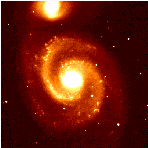
 We believe that most of the matter in the universe is dark, i.e. cannot be detected from the light which it emits (or fails to emit). This is "stuff" which cannot be seen directly -- so what makes us think that it exists at all? Its presence is inferred indirectly from the motions of astronomical objects, specifically stellar, galactic, and galaxy cluster/supercluster observations. It is also required in order to enable gravity to amplify the small fluctuations in the Cosmic Microwave Background enough to form the large-scale structures that we see in the universe today.
We believe that most of the matter in the universe is dark, i.e. cannot be detected from the light which it emits (or fails to emit). This is "stuff" which cannot be seen directly -- so what makes us think that it exists at all? Its presence is inferred indirectly from the motions of astronomical objects, specifically stellar, galactic, and galaxy cluster/supercluster observations. It is also required in order to enable gravity to amplify the small fluctuations in the Cosmic Microwave Background enough to form the large-scale structures that we see in the universe today.
For each of the stellar, galactic, and galaxy cluster/supercluster observations the basic principle is that if we measure velocities in some region, then there has to be enough mass there for gravity to stop all the objects flying apart. When such velocity measurements are done on large scales, it turns out that the amount of inferred mass is much more than can be explained by the luminous stuff. Hence we infer that there is dark matter in the Universe.
Dark matter has important consequences for the evolution of the Universe and the structure within it. According to general relativity, the Universe must conform to one of three possible types: open, flat, or closed. The total amount of mass and energy in the universe determines which of the three possibilities applies to the Universe. In the case of an open Universe, the total mass and energy density (denoted by the greek letter Omega) is less than unity. If the Universe is closed, Omega is greater than unity. For the case where Omega is exactly equal to one the Universe is "flat".
Note that the dynamics of the Universe are not determined entirely by the geometry (open, closed or flat) unless the Universe contains only matter. In our Universe, where most of Omega comes from dark energy, this relation between the mass density, spatial curvature and the future of the universe no longer holds. It is then no longer true in this case that "geometry (spatial curvature) is destiny." Instead, to find out what will happen one needs to calculate the evolution of the expansion factor of the universe for the specific case of matter density, spatial curvature and "funny energy" to find out what will happen.
Dark matter was invoked to explain how galaxies stick together. The visible matter alone in galaxies - stars, gas and dust - is nowhere near enough to hold them together, so scientists reasoned there must be something invisible that exerts gravity and is central to all galaxies.
Last August, an astronomer at the University of Arizona at Tucson and his colleagues reported that a collision between two huge clusters of galaxies 3 billion light-years away, known as the Bullet Cluster, had caused clouds of dark matter to separate from normal matter.
Many scientists said the observations were proof of dark matter's existence and a serious blow for alternative explanations aiming to do away with dark matter with modified theories of gravity.

No comments:
Post a Comment